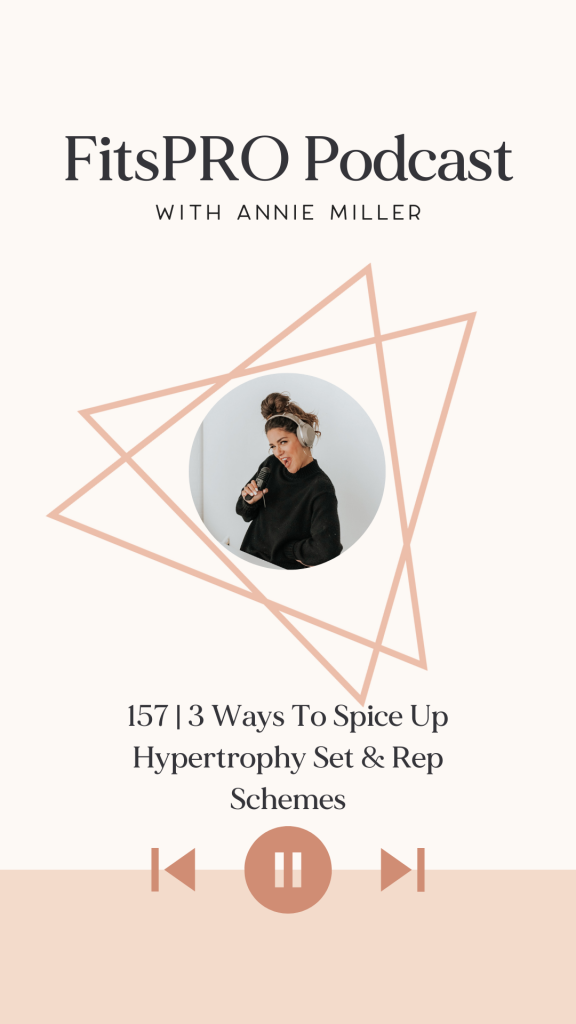the blog
welcome to
looking for something specific? find it here
Podcast: Play in new window | Download (Duration: 18:06 — 25.0MB)
Subscribe: Google Podcasts | RSS

Today we are only going to talk about three different ways to spice up your hypertrophy set and reps schemes.
All three of them are going to add time under tension in their own respect.
These applications will be added to whatever it is that you are already doing with your training. So I am going to be very specific into how you can use these three methods, whether it be worth one of your lives in your training program, or all of them.
To start off, a standard set and rep scheme includes sets (which is how many rounds you do) and reps (which is how many repetitions you perform within each set). And then we also have tempo. And load. You also have rest periods but we won’t be discussing those today.
That could look like seven sets of three, or five sets of four, or three sets of 15. Your rep scheme could also be wave loading, or some thing a bit more complicated. It could be four by four and increasing weight by 3% each set. It could be a pyramid scheme, where you either increase reps and decrease load on the way up and then do the reverse on the way down. Or like I said wave loading, which could be 642642, using appropriate weights at each of those. Which we won’t get into the specifics of right now.
Just know that those sets and reps will be assigned for every single exercise that you do with an work out. Now let’s get into what you can do or tack on in addition to your normal sets and reps.
Number one and number two go hand-in-hand, in adding specific time under tension in the bottom half of a movement. Or where the extent of the eccentric contraction is happening more often than not.
3 ways to spice up hypertrophy set & rep schemes:
Pauses
You can technically put a pause at any portion of a movement. They are commonly seen at say the bottom of a squat, or at mid shin during a dead lift, or at the top or middle of a pull up.
Adding a pause can be for a single second, or 10 seconds. Or anywhere in between and or beyond that. Point being, to add that time under tension during a specific area of the muscle contraction. And that will be determined by yourself or your coach.
How you might implement this could look different depending on the lift. I’ll use hip thrusts as an example. The pause here will happen at the top of the thrust, with full glute max contraction. You could do this at the top of each rep for say two seconds, or you could add a big contraction on the last rep of each set for 10 seconds. That isometric contraction briefly increases the intensity of the lift, and certainly the demand on the muscle fibers at that point of the movement.
For something like a bicep curl, you could add a pause halfway down. I would curl all the way up, lower halfway down pause for a second or two lower all the way down and then straight back into the next rep. This would be adding extra tension in the mid range of the lift. You could also pause near a sticking point of a lift if you wanted to work on strengthening the muscles within the degrees where are the sticking point happens.
Again, the basics of a pause is that it’s an isometric contraction of the muscle with in either the E centric or the con centric contraction of muscle.. It’s a fun, simple way to spice up your training if you feel you need it. Or if you were looking for a way to spice up PROgramming for your clients, without altering other factors like exercise selection.
Pulses
I first experienced using pulses in a bodybuilding phase when I was probably 20 years old or so. And I’ve never been so sore in my entire life up to that point.
At the bottom of the last rep of every set, we performed 5 to 10 pulses before finishing the last rep. It was absolutely brutal. We were using a weight it was probably an RPE 8 but quickly became an RPE 9 or 10 because of the pulses.
Let’s take shoulder press for this example. Any shoulder press variation. You complete your three sets of eight reps. That’s the rep scheme we’re working with. Now we’re going to add five pulses at the bottom of the last rep of each set. So we’re only pulsing on one rep per set. Perform seven shoulder presses, lower down for your eighth, and then do five, 2 to 3 inch repetitions in the bottom of the movement. And then finish out the rep pressing all the way to the top.
So spicy, and I would imagine wildly effective for hypertrophy if that was the goal.
Like I said in the beginning, this is just another way to add more time under tension and muscle fatigue to what’s already happening. Without changing much of the programming as it stands.
I would consider pulses a cousin of pauses and quarter or half reps. It’s kind of the in between of those two methods.
It’s not quite an isometric contraction, and the range of motion is smaller than that of a quarter rep.
We discussed how to use this on one reps of a set, but you could use it like a one and a quarter wrap and add 2 to 3 pulses at the bottom of every rep if you wanted to.
Take a reverse lunge or a walking lunge for instants. He would lunge back or forward to three small pulse is at the bottom and then come up to finish the rep step in to your next one, 3 small purses and up next one, 3small pulses and up so on and so forth.
I’m sure you can imagine the muscle demand and fatigue that brings to the table.
So sure, you could just increase load, or increase total volume. But today is about little ways that you can spice up programming outside of the norm. Take them or leave them for what it’s worth to you.
Back off sets
This is more traditionally used in powerlifting I believe. But I’m sure it has its place in bodybuilding as well. This is an effective way to increase muscle fatigue after strength sets.
I see the best use of pulses in large compound lifts. Even things like a hip thrust, RDL, or pull-ups. Movements where are you may be working in lower rack seems very high loads.
We haven’t talked about pull-ups yet, so let’s use that. But remember that this can apply to deadlifts, or squats, or benchpress as well.
Perhaps it’s programmed for four sets of three on assisted pull-ups. That’s relatively low volume. And while you can cause hypertrophy via many different set, rep, and load schemes, it might be worth tacking on some good old fashion volume.
In this case, you would use assistance, and maybe do one or two back off sets at higher reps. Let’s say 8 to 10.
They are called back offsets because the intensity is much lower. You were taking off load, in order to fatigue the muscles at a lighter load. You’re backing off.
With push-ups, you could even do this as push-ups from the toes, and then lowering to your knees as a back offset.
What I want you to grasp is that you were simply lowering the load. So back to the pull ups. If you were doing weighted pull ups, maybe your back offsets are at bodyweight.
Especially if a person has been in a strength phase for a long time, or maybe a client really likes high rep stuff that they need to work strength, implementing back offsets can be kind of a happy medium.
Leave the FitsPRO Podcast a review


If you find value here, on The FitsPRO Podcast, then pretty please head over to iTunes, subscribe, rate and review the show. It means the world to me when you spread my message to more humans.
Want more podcasts? Click here to skim the archives.
P.S. Save this value packed episode for later over on Pinterest!
ALL THE LINKS YOU NEED:
Free On Demand Workshop: 3 Steps To Build a Profitable Online Health and Fitness Business
Supplements: Legion Athletics Code ANNIE for 20% off
Skincare: Fré Skincare Code FDBA for at least 15% off
Bags: Vooray Code ANNIE for 20% off
I'm an adventurous introvert from Vancouver, Washington who lives on sleep + "me time." I'm a lover of lifting weights, dinosaurs, real talk and traveling with my husband. I am here to help you move better, lift more, bust the myths of the fitness industry, and inspire you to love the process.
Hey you,
The name's Annie & you're reading my thoughts. Let's get acquainted.
the whole story >
looking for something specific? find it here
THE LINKS BELOW ARE AFFILIATE LINKS
SKIN CARE
Nutrition
brands I love
working against gravity
Fre skin care
favorites
blue light blockers
klassy network
code: fdba saves you 15% off
online TRAINERS
save $50
code: ANNIE saves you 20% off
You love my style, trust my reviews, and want more Annie Miller Concepts vibes in your life? Shop my favorite brands. You get awesome products and yours truly gets a little kick-back.
